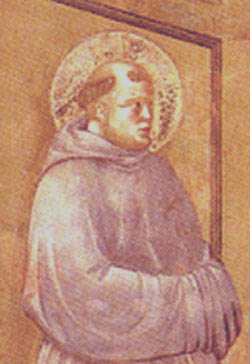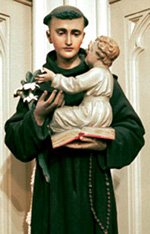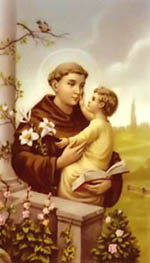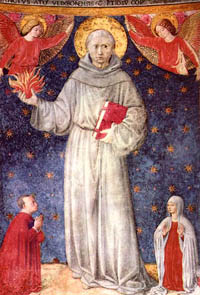Today is the feast day of
St. Anthony of Padua, called “Ark of the Covenant” for his profound
knowledge of Scriptures and “Hammer of Heretics” for his skill in
applying that knowledge in polemics. It is customary in the churches of
many Western nations to place the statue of St. Anthony in a special
place of honor to be venerated by the faithful on his feast day.
I also bought some other picture that represented St. Anthony that was sold at the door of the church. This one was not by Giotto, but by some unknown author who portrayed the common picture of St. Anthony. It showed a young man with soft skin, pink cheeks, and the mindless and somewhat foolish air of one who does not understand anything. In his arms he is holding a Child Jesus, who appears to not understand what he is doing in the arms of that man. He has the air of someone who says: “I am sorry to be here, it probably happened by some mistake. But it seems that we will still have to bear this for a while.” In St. Anthony’s face, there is nothing that expresses the Doctor of the Church, the man who was considered the greatest expert in Scriptures of his time. He knew everything in Scriptures and used to quote it by heart; he knew even its most arcane and difficult passages. He was not only able to quote such texts, but used to comment on them and draw concrete consequences from them to smash the heretics and to encourage the faithful.
The militant St. Anthony is the authentic one, depicting the way he lived on earth in his times and the way he is now in Heaven. But today his true moral physiognomy, which the Church presents as a model, has almost completely disappeared. The figure that replaced him is a sentimental one only concerned about giving graces and favors. There is a fundamental difference in the physical figure, but most of all, there is a fundamental difference in the moral figure of St. Anthony. In addition to being honored with the aforementioned titles – Ark of the Covenant and Hammer of the Heretics – St. Anthony is also the Patron of the Army. The reason for that is linked to two incidents where, from Heaven, he intervened in a militant way. The first was when a Spanish fleet was besieging the Muslim city of Oram and facing a long and fruitless siege. In such circumstance, the Spanish Admiral went to a statue of St. Anthony to ask his intercession. He told St. Anthony that he, the Admiral, could do nothing more without some extraordinary help. Then he turned over his insignias of command to the statue and placed his Admiral’s hat on its head. Then he asked St. Anthony to take command of the siege against Oram and conquer the city. Soon after this, the Moors suddenly left the city. Some who were captured and interrogated related that they had seen a Friar coming from Heaven with an Admiral’s hat on his head. He threatened the Moors that he would send fire from Heaven upon them unless they left the city. In face of this peril, the Muslims found it more prudent to leave. The second incident took place in Rio de Janeiro when it was being attacked by the French Calvinist fleet. The Calvinists had a great advantage over the Brazilian Catholics, who could no longer offer an effective resistance. At that point, the Franciscan Friars took a statue of St. Anthony from their monastery to a central square in Rio and set it on a column.
The common devotion to St. Anthony normally does not mention things like this. He is presented as a sweet, foolish saint who only likes to arrange marriages and enjoy his feast day. This kind of sentimental piety distorted the physiognomy of the great St. Anthony to hide his militancy. I think that we have the obligation to correct this false piety and help restore the true moral physiognomy of the saints. For it is easy to see that this distortion has been effected not only with St. Anthony, but also with many other saints. Let us ask St. Anthony to give us the necessary graces to help extirpate this false piety and to become enthusiastic admirers of Catholic militancy, as he was. | Prof. Plinio Corrêa de Oliveira |
St. Clare is the little plant of St. Francis, as she called herself. A blog to my call to become a Poor Clare Colettine. If St. Clare was a "little plant", I am a scraggly weed.
Search This Blog
Wednesday, June 12, 2013
Today is the Feast of St. Anthony of Padua, the "Hammer of Heretics" by Prof. Plinio Corrêa de Oliveira
Subscribe to:
Post Comments (Atom)





No comments:
Post a Comment